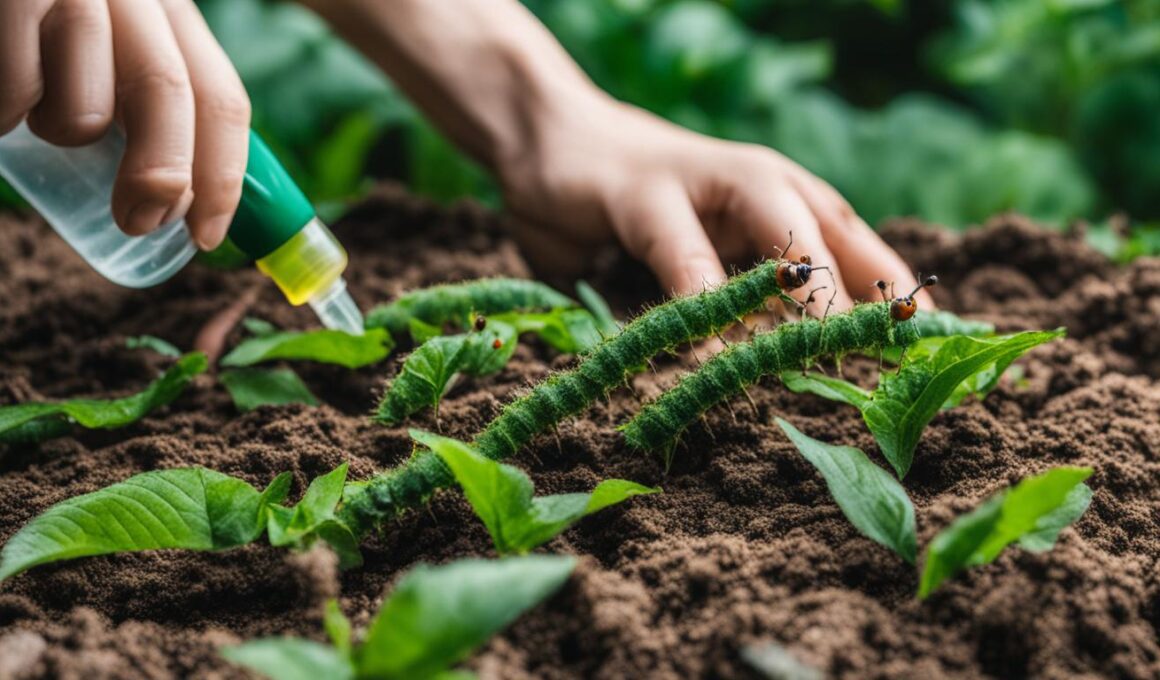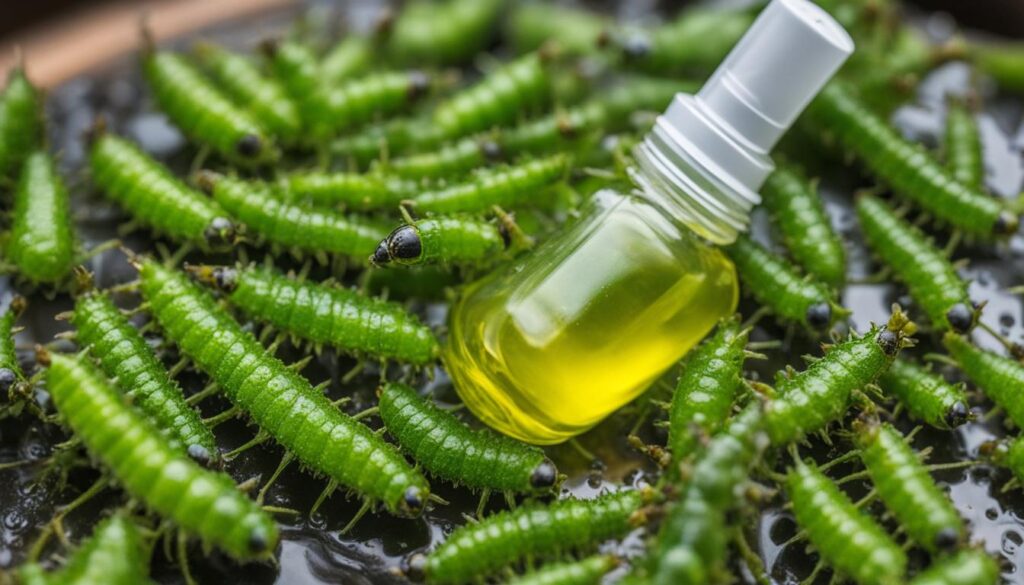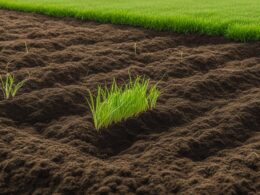Caterpillars can be a nuisance in your garden, causing damage to your plants and negatively impacting their growth. If you’re dealing with a caterpillar infestation, it’s important to take swift action to prevent further harm. In this article, we will discuss some effective methods for getting rid of caterpillars and maintaining a pest-free garden.
Key Takeaways:
- Hand removal is a safe and efficient method for controlling caterpillars, allowing you to physically remove them from your plants.
- Neem oil is a natural and non-toxic solution that repels and suffocates caterpillars, protecting your plants without harming the environment or beneficial insects.
- A garlic solution works as a smelly deterrent for caterpillars, creating an unpleasant environment that they will avoid.
- Bacillus Thuringiensis (Bt) is an eco-friendly bacteria that selectively targets caterpillars, providing an effective control method.
- Pepper spray, made from habanero peppers, can be used to repel caterpillars with its strong scent and taste.
Hand Removal: An Old-Fashioned Technique for Caterpillar Control
When it comes to eliminating caterpillars from your garden, sometimes the simplest methods are the most effective. Hand removal, an age-old technique, remains a reliable way to control caterpillars and protect your plants. By taking matters into your own hands, you can physically remove these pesky pests and restore harmony to your garden.
Don’t be afraid to get your hands dirty. Begin by wearing gloves to protect your skin and prevent any potential irritation. Carefully inspect your plants, paying special attention to the leaves, stems, and undersides of foliage. As you spot the caterpillars, gently pluck them off your plants and place them into a container, ensuring they are unable to escape.
This method allows you to focus on specific areas where caterpillars are present, effectively reducing their population within your garden. By removing the caterpillars by hand, you avoid the use of pesticides and maintain the environmental balance of your garden. Hand removal is safe for both your plants and beneficial insects, ensuring a healthy and thriving ecosystem.
Remember to be thorough and persistent in your efforts. Regularly monitor your plants for any signs of caterpillars and continue with hand removal as needed. By staying proactive, you can stay one step ahead of these leaf-munching creatures and keep your garden flourishing.
Hand removal is a safe, non-toxic method for caterpillar control. By physically removing these pests from your garden, you can minimize their impact on your plants and maintain a healthy environment. So put on your gloves and get ready to keep caterpillars at bay!
In addition to hand removal, there are several other effective methods for controlling caterpillars and preserving the beauty of your garden. Stay tuned for the following sections, where we will explore natural solutions such as neem oil, garlic sprays, Bacillus Thuringiensis, and even homemade pepper spray, all designed to combat caterpillar infestations and restore harmony to your outdoor space.
Neem Oil: A Natural Solution for Caterpillar Infestations
When it comes to controlling caterpillar infestations, neem oil is a natural and effective solution. Derived from the neem tree, this botanical extract is well-known for its insecticidal properties.
Neem oil works by suffocating and repelling caterpillars when sprayed on plants. It creates a protective barrier that prevents them from causing damage to your precious garden. By using neem oil, you can effectively deter caterpillars and preserve the health of your plants.
One of the reasons why neem oil is a popular choice for caterpillar control is its safety. Unlike synthetic pesticides, neem oil is non-toxic to humans, pets, and beneficial insects. This means that you can safely use neem oil around your family, animals, and the environment without any worries.
To use neem oil for caterpillar infestations, simply dilute it according to the instructions on the product label and apply it to your plants using a sprayer. Be sure to cover both the upper and lower surfaces of the leaves for maximum effectiveness.
Remember: Neem oil is most effective when applied during the early stages of caterpillar infestation. Regularly monitoring your plants and taking action at the first signs of caterpillars can help prevent widespread damage.
By incorporating neem oil into your pest control routine, you can effectively combat caterpillar infestations and protect the beauty and health of your garden.
Garlic Solution: A Smelly Deterrent for Caterpillars
Caterpillars can wreak havoc on your garden, but there’s a simple and natural solution to keep them at bay – garlic. These leaf-munching pests can’t stand the strong smell of garlic, making it an effective deterrent. By creating a homemade garlic solution, you can protect your plants without the use of harmful chemicals.
To prepare the garlic solution, mix crushed garlic cloves, a few drops of dish soap, and water in a spray bottle. The dish soap helps the solution stick to the leaves of your plants. Shake the bottle well to ensure the ingredients are thoroughly combined.
Once your garlic solution is ready, generously spray it on the foliage of your affected plants. Pay special attention to the undersides of the leaves, as caterpillars tend to hide there. The pungent odor of the garlic will repel caterpillars, keeping them away from your garden.
To achieve optimal results, it’s important to regularly apply the garlic solution to your plants. This will help maintain the scent and effectiveness of the deterrent. After rain or heavy watering, be sure to reapply the solution to ensure continued protection.
Not only is the garlic solution an effective deterrent, but it’s also safe for your plants, pets, and beneficial insects. By using this natural method, you can protect your garden from caterpillar damage and enjoy a thriving, pest-free environment.
Bacillus Thuringiensis: Using Nature to Control Caterpillars
Bacillus Thuringiensis, or Bt, is a naturally occurring bacteria that is toxic to caterpillars when ingested. This environmentally friendly solution can be applied to your plants to selectively control caterpillar populations without harming beneficial insects or other wildlife. Bt is safe for use in organic gardening and is a powerful tool in caterpillar control.
Caterpillars can wreak havoc on your garden, damaging your beautiful plants and causing frustration. Thankfully, there are natural methods available to effectively control these pests and maintain the health and beauty of your garden. One such method is the use of Bacillus Thuringiensis, a naturally occurring bacteria that offers a safe and eco-friendly solution to caterpillar infestations.
Bacillus Thuringiensis is a naturally occurring bacteria that targets and control caterpillars, offering an effective and non-toxic alternative to chemical pesticides.
The use of Bacillus Thuringiensis involves applying the bacteria to your plants, where it is ingested by caterpillars as they feed. Once ingested, the bacteria release toxins that specifically target caterpillars, causing them to stop feeding and eventually die. The beauty of this method lies in its selectivity, as it poses no harm to beneficial insects or other wildlife in your garden.
Organic gardeners especially appreciate the use of Bacillus Thuringiensis, as it aligns with their commitment to eco-friendly practices. By harnessing the power of nature, you can effectively control caterpillars and maintain the balance of your garden ecosystem.
Pepper Spray: A Spicy Solution for Caterpillar Repellent
If you’re looking for a natural and effective way to repel caterpillars from your garden, pepper spray can be your spicy solution. By creating a homemade caterpillar repellent with habanero peppers, garlic, water, vegetable oil, and dish soap, you can deter these pests from feasting on your plants.
The strong scent and taste of the peppers act as a powerful deterrent, making your plants unappetizing for caterpillars. The capsaicin in hot peppers is known to repel insects due to its irritating effect on their taste receptors.
To make your own pepper spray, follow these simple steps:
- Chop 4-6 habanero peppers and 4-5 garlic cloves.
- In a blender, combine the chopped peppers, garlic, 2 cups of water, 1 tablespoon of vegetable oil, and 1 teaspoon of dish soap.
- Blend the mixture until it forms a smooth consistency.
- Use a strainer or cheesecloth to filter out any solid particles.
- Pour the resulting liquid into a spray bottle.
Before applying the pepper spray to your plants, it’s essential to perform a patch test on a small area to ensure it doesn’t cause any adverse effects. Once confirmed safe, spray the repellent on the leaves and stems of your vulnerable plants, focusing on areas where caterpillars are commonly found.
Remember to reapply the pepper spray after rain or heavy watering to maintain its effectiveness as a deterrent. However, be cautious when handling pepper spray, as it can cause skin and eye irritation. Always wear gloves and avoid contact with sensitive areas.
With its natural and potent properties, pepper spray offers an environmentally friendly and efficient way to protect your plants from caterpillars. By incorporating this spicy solution into your pest control regimen, you can reclaim your garden from these voracious leaf-eaters and enjoy a thriving, caterpillar-free environment.
Conclusion
In conclusion, if you’re dealing with caterpillar infestations and want to protect your garden from their destructive behavior, you have several effective methods at your disposal. Whether you opt for hand removal, neem oil, garlic solution, Bacillus Thuringiensis, pepper spray, or a combination of these techniques, you can reclaim your garden and enjoy a pest-free environment.
Hand removal allows you to physically target and remove caterpillars from your plants, while neem oil suffocates and repels them without harming beneficial insects. The strong smell of garlic can serve as a natural deterrent, and Bacillus Thuringiensis selectively controls caterpillar populations without posing a threat to other wildlife. Additionally, pepper spray, made from spicy ingredients, can discourage caterpillars from feeding on your plants.
When deciding on the best method for your needs, consider your preferences, surrounding environment, and the severity of the infestation. By implementing these proven techniques, you can bid farewell to caterpillar infestations and welcome a flourishing and healthy garden. Say goodbye to the destruction and enjoy the beauty and abundance of a well-protected outdoor space.
Can the Methods Used to Get Rid of Caterpillars Also Work for Mole Crickets?
Yes, the methods used for getting rid of mole crickets can also work for getting rid of caterpillars. By utilizing natural predators, such as birds or nematodes, and applying organic insecticides, you can effectively control both pest populations in your garden or lawn without harming the environment.
FAQ
How do I get rid of caterpillars in my garden?
There are several effective methods for controlling caterpillars. You can try hand removal, using neem oil, making a garlic solution, using Bacillus Thuringiensis, or creating a pepper spray repellent. Each method has its benefits, so choose the one that suits your preferences and needs.
What is hand removal and how does it work?
Hand removal involves physically picking caterpillars off your plants. By wearing gloves and targeting specific areas where caterpillars are present, you can safely remove them from your garden without harming your plants or the environment.
How does neem oil help control caterpillar infestations?
Neem oil, derived from the neem tree, has insecticidal properties that suffocate and repel caterpillars. When sprayed on plants, it prevents caterpillars from causing damage. Neem oil is safe for use around humans, pets, and beneficial insects.
How can I create a garlic solution to deter caterpillars?
You can make a homemade spray by mixing garlic, dish soap, and water. Caterpillars dislike the strong smell of garlic, so regularly applying this solution to your plants can help keep them away and protect your garden.
What is Bacillus Thuringiensis, and how does it control caterpillars?
Bacillus Thuringiensis, or Bt, is a naturally occurring bacteria that is toxic to caterpillars when ingested. It can be applied to your plants to selectively control caterpillar populations without harming beneficial insects or other wildlife. Bt is safe for use in organic gardening.
How can I create a pepper spray caterpillar repellent?
You can blend habanero peppers, garlic, water, vegetable oil, and dish soap to create a homemade pepper spray. The strong scent and taste of the peppers will discourage caterpillars from feeding on your plants.











